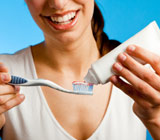 You use toothpaste every day — don’t you? But how much do you really know about what’s inside the tube: namely, the white, sticky stuff that keeps your teeth clean and your breath fresh? Take this True/False quiz and find out!
You use toothpaste every day — don’t you? But how much do you really know about what’s inside the tube: namely, the white, sticky stuff that keeps your teeth clean and your breath fresh? Take this True/False quiz and find out!
True of false: Powdered charcoal, brick dust and crushed bones were once ingredients in toothpaste. TRUE
Many years ago, these gritty abrasive materials were used to make toothpaste. Today, abrasives are still used — but they’re much gentler. Compounds like hydrated silica or alumina, calcium carbonate, and dicalcium phosphate have proven effective at cleaning and polishing tooth surfaces without damaging the enamel.
True of false: Fluoride was first introduced into toothpaste in 1955. FALSE
Arguably toothpaste’s most important ingredient, fluoride was used as early as 1914. But its mass-marketing debut came with the Crest brand in the mid-1950s. Today, no toothpaste without fluoride can receive the American Dental Association’s Seal of Approval. That’s because it has been shown to strengthen tooth enamel and help prevent tooth decay.
True of false: Detergent is a common ingredient of toothpaste. TRUE
But it isn’t the same kind you do laundry with. Detergents — also called surfactants, because they act on the surfaces of liquids — help to loosen and break down deposits on your teeth, which can then be rinsed away. Like other health and beauty products, many toothpastes use a gentle detergent, derived from coconut or palm kernel oil, called sodium lauryl sulfate.
True of false: Whitening toothpastes work, to some degree, on all stains. FALSE
Whether the whitening agents in toothpaste will work for you depends on why your teeth don’t look white in the first place. The abrasives and enzymes in these toothpastes can help remove “extrinsic” stains: those on the surface of your teeth. But for “intrinsic” stains — that is, internal discoloration — they probably won’t help. In that case, you may need to get professional bleaching treatments.
True of false: Toothpastes made for sensitive teeth have substances that block pain transmission. TRUE
Potassium nitrate and strontium chloride can block the sensation of pain that may occur when dentin — the material that makes up most of the inside of teeth, and is normally covered by enamel — becomes exposed. Fluoride, too, helps reduce sensitivity. But the benefits of reduced tooth sensitivity may take a few weeks to really be felt.
If you have questions about toothpastes or oral hygiene, please contact us or schedule an appointment for a consultation. You can learn more in the Dear Doctor magazine article “Toothpaste — What’s In It?”